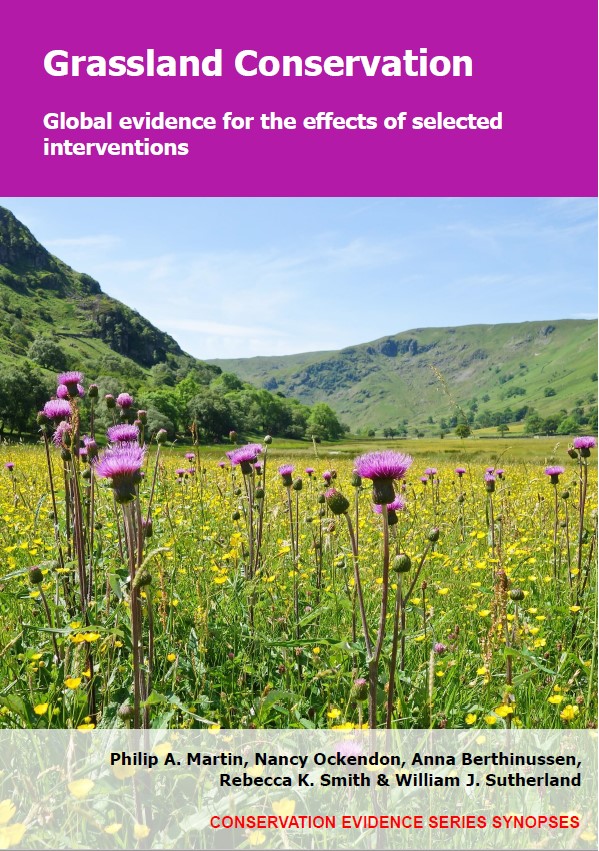Plant grassland plants
-
Overall effectiveness category Evidence not assessed
-
Number of studies: 4
View assessment score
Hide assessment score
How is the evidence assessed?
-
Effectiveness
not assessed -
Certainty
not assessed -
Harms
not assessed
Study locations
Supporting evidence from individual studies
A replicated, randomized, paired, controlled study in 1994–1996 at six improved grassland sites in the UK (Hopkins et al. 1999) found that planting individual plants increased grass and forb species richness in more than half of cases. In six of 12 comparisons, the number of grass species was higher in plots where individual plants had been planted (5–12 species/plot) than in areas where no plants were planted (4–10 species/plot), while in six comparisons the number of grass species was equal to or lower than that found in areas where no plants were planted (5–13 species/plot vs 5–13 species/plot). In 10 of 12 comparisons, forb species richness was higher in areas where plants were planted (7–22 species/plot) than where no plants were planted (4–15 species/plot), while in two comparisons there were equal or fewer numbers of forb species (4–5 species/plot vs 5 species/plot). In 1994, at each site, plants of nine forb species were planted in four 6 × 4 m plots, and no plants were planted in another four plots. In May/June of 1995 and 1996, the frequency of each grass and forb species was recorded in three 40 x 40 cm quadrats in each plot.
Study and other actions testedA study in 1998–1999 in a grassland restoration site near Holleben, Germany (Bischoff 2000) found that transplanted pepper saxifrage Silaum silaus plants spread to adjacent grassland, and 44% of new seedlings survived over four months. During the year following transplantation, new seedlings emerged up to 4.5 m from transplanted pepper saxifrage plants, although the majority (74%) were recorded within 1.5 m. Forty new seedlings were monitored with 44% surviving for at least four months after germination. In 1998, fifteen pepper saxifrage plants with almost ripe seeds were transplanted to the centre of each of four 10-m2 plots within a floodplain. The site was managed with grazing and cutting. In May and July 1999, new seedlings were recorded within 50 x 0.25 m2 quadrats positioned in circles at distances of 1–5 m around each transplant. Ten seedlings in each of the four plots were marked and survival was recorded every 3–4 weeks in May–September 1999.
Study and other actions testedA review in 1996–2009 of four studies of semi-natural grassland restoration in the UK and Australia (Hedberg & Kotowski 2010) found that planting grassland plants had mixed effects on planted species abundance. One of four studies of planting to restore semi-natural grasslands reported successful introductions of planted species, while one study reported limited success, one reported a failed reintroduction, and one did not report enough information to allow the success of introductions to be determined. The review used keyword searches to identify studies where semi-natural grassland restoration was carried out. All studies on planting used plug plants grown in a nursery.
Study and other actions testedA replicated, controlled study in 1998–2004 in agricultural fields in Indiana, USA (Middleton et al. 2010) found that areas planted with seedlings in addition to seeding with grassland species contained more plant species, and more native plant species, than areas that were only seeded. After one to four years, areas that were planted and seeded contained more species (16–19) than those that were only seeded (6–12). The number of native species was also higher in the planted and seeded plots compared to the seeded only plots (data not given). Both treatments were carried out on former arable land using locally collected seed. The planting and seeding treatment was applied to a different 14 x 24 m plot each year from 2001–2004. Seedlings of 11 species were planted. The seeding treatment was applied to a different parcel of land each autumn from 1998–2004. No information was provided about the size of seeded areas, seeding rates or timing. Seeded plots were mown in the first year after planting, and invasive plants were treated with herbicide. Plant species were recorded within twenty-four 2 x 2 m quadrats in each seeded area, and 18 quadrats in each seeded and planted area.
Study and other actions tested
Where has this evidence come from?
List of journals searched by synopsis
All the journals searched for all synopses
This Action forms part of the Action Synopsis:
Grassland Conservation
Grassland Conservation - Published 2021
Grassland Synopsis





)_2023.JPG)














